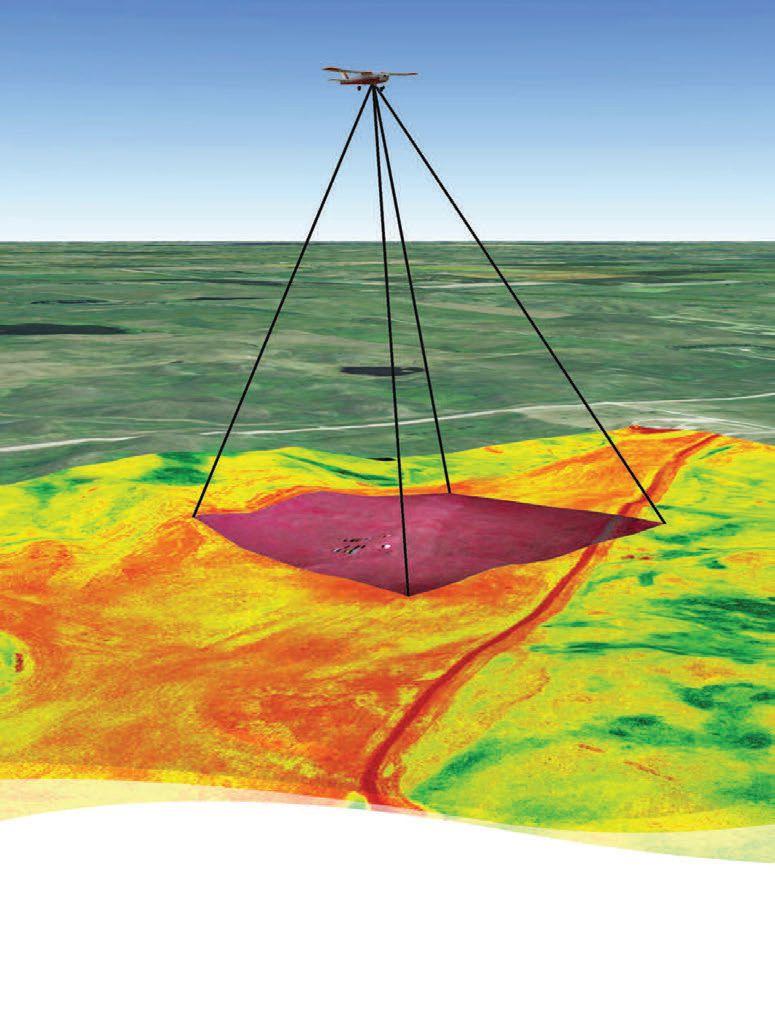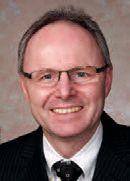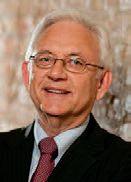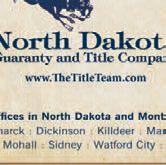








North Dakota was the ideal place for Field of View, LLC to develop its aerial imaging technology that helps farmers save time and money. With strong agriculture, technology and aviation sectors, we’re doing business better. Learn more about the North Dakota Department of Commerce and companies in the state at www.NDBusiness.com
 Photo courtesy of Field of View, LLC
KRIS BEVILL
Photo courtesy of Field of View, LLC
KRIS BEVILL


 MATTHEW D. MOHR
MATTHEW D. MOHR






Just minutes before I started typing this column, national news outlets reported that Congress had reached a deal to stave off a U.S. default and end the more than two-week federal government shutdown that has furloughed thousands of federal employees, closed national parks and impacted millions of Americans to varying degrees of severity. Here at the magazine, our work was surprisingly affected by the shutdown. Some of the data we rely on was unavailable until the last minute because federal agencies responsible for providing that information to the public were deemed non-essential. Interviews with federal agency officials had to be put on hold and eventually cancelled as the shutdown dragged on beyond our deadlines. A local small business summit had to be postponed because the keynote speaker was a government employee and would not have been able to attend the event.
But our troubles pale in consideration to some of the issues being faced by others around the region. Shortly after the shutdown went into effect, an historic blizzard ravaged the Black Hills, resulting in the deaths of thousands of cattle. It is still unknown exactly how many cattle perished in the storm, but it is estimated to be 10,000 to 20,000. Some ranchers lost everything. Many will be economically devastated for years. Normally, ranchers in situations like this would look to the Farm Service Agency for help in tallying their financial losses and accessing what little federal aid might be available, but because the government was shutdown they had nowhere to turn. We hope federal officials can get back to work soon enough to offer some relief to those affected by the storm.
Ironically, this issue of the magazine covers the Affordable Care Act, which was the crux of the shutdown. In preparing for this article I attended informational meetings hosted by private industry and spoke with several health reform experts who know the ins and outs of the law and have been explaining the details to businesses and private individuals for the past year. They all said they still come across business owners who, either due to wishful thinking or misinformation, don’t believe that the new law will go into effect. The shutdown didn’t help matters. So, to be clear, the ACA is happening and will go into effect on Jan. 1. That’s the simplest part of understanding the law. For answers to some of the other commonly asked questions and concerns, read, “Health Care Reform 101.”
We’re Spherion®, a local staffing firm with a passion for placing the right candidate in the right company. We have been serving the flexible and direct-hire staffing needs of businesses since 1946. Our staffing specialties include:
• Administrative & Clerical
• Contact Center

• Light Industrial
• Non-Clinical Healthcare
• Professional
When you love what you do, it shows. Put Spherion’s passion for staffing to work for you!
www.spherion.com
If all this talk of shutdowns and health care policy makes you thirsty for an adult beverage (I know it does to me) then you’ll certainly want to check out our cover feature, “A Brewing Industry.” We all know it’s not uncommon for states in this region to regularly appear on lists that tally the number of drinking establishments or drinks consumed per capita, so it is somewhat of a mystery that the number of craft breweries in these states has been few or none. That’s beginning to change. In the past year, a number of microbreweries have been established throughout our readership area and are quickly becoming known as unique places for locals to gather and as attractants for outof-town guests and tourists. The independent, unique vibe of these breweries meshes well with downtown redevelopment efforts and we expect they will play a hefty role in the rejuvenation of downtown economies throughout our region in coming years. Cheers to that.
MIKE JACOBS,Publisher
RONA JOHNSON, Executive Editor
KRIS BEVILL, Editor
BETH BOHLMAN, Circulation Manager
KRIS WOLFF, Layout Design, Ad Design
Sales Director: JOHN FETSCH
701.212.1026 jfetsch@prairiebizmag.com
Sales:
BRAD BOYD - western ND/western SD 800.641.0683 bboyd@prairiebizmag.com
SHELLY LARSON - eastern ND/western MN 701.866.3628 slarson@prairiebizmag.com
Editor: KRIS BEVILL 701.306.8561 kbevill@prairiebizmag.com

Editorial Advisors:
Dwaine Chapel, Executive Director, Research Park at South Dakota State University; Bruce Gjovig, Director, Center for Innovation; Lisa Gulland-Nelson, Vice President, Marketing and P.R., Greater Fargo Moorhead EDC; Tonya Joe (T.J.) Hansen, Assistant Professor of Economics, Minnesota State University Moorhead; Dusty Johnson, Chief of Staff for South Dakota Gov. Dennis Daugaard’s office; Brekka Kramer, General Manager of Odney; Matthew Mohr, President/CEO, Dacotah Paper Company; Nancy Straw, President, West Central Initiative
Prairie Business magazine is published monthly by the Grand Forks Herald and Forum Communications Company with offices at 375 2nd Avenue North, Grand Forks, ND 58203. Qualifying subscriptions are available free of charge. Back issue quantities are limited and subject to availability ($2/copy prepaid). The opinions of writers featured in Prairie Business are their own. Unsolicited manuscripts, photographs, artwork are encouraged but will not be returned without a self-addressed, stamped envelope.
Subscriptions Free subscriptions are available online to qualified requestors at www.prairiebizmag.com
Address corrections
Prairie Business magazine PO Box 6008
Grand Forks, ND 58206-6008
Beth Bohlman: bbohlman@prairiebizmag.com
Online www.prairiebizmag.com
With the year nearing completion, a business should have a very good feeling for its success (or failure) in generating additional cash flow for the year. Profits are important as a measure of success, but real cash flow is the measure of sustainability over time. A business may not generate cash every year, but over time cash must be generated to pay creditors and provide a return to investors.
New enterprises, especially in technology, require cash to operate. Without cash, wages can’t be paid and necessary expenses such as rent, power, communications and supplies can’t be acquired. The amount of cash a startup (or even a mature business in transition) needs to pay during a given period of time for its ongoing bills is called the enterprise’s “burn rate.” In other words, how much cash are you burning through during a certain period of time just to stay alive?
One regional technology based startup I am familiar with received sufficient funding from investors to get started, but fell short of necessary cash flow to keep paying staff once the business got rolling. The principles accepted no wages until the business grew to the point of being able to pay them and all its bills. Without the initial investment the business would have failed, but by determining its real burn rate and having patient investors, the business made it to the point of positive cash flow, which is not easy to do in a pure technology enterprise. The next step for that business will be to grow to the point where cash flow supports expansion and extraordinary returns to its investors.
Cash flow is the true measure of success for a business over time. PB
 Matthew D. Mohr CEO, Dacotah Paper Co. mmohr@dacotahpaper.com
Matthew D. Mohr CEO, Dacotah Paper Co. mmohr@dacotahpaper.com


Federal budget issues continue to dominate headlines in seemingly endless repetition. The divide between political parties is so extreme that budget crises and the possibility of government shutdowns have become a routine part of life. There is significant uncertainty about the future of government tax and expenditure policies and how this will impact the country, and the region. Similar problems exist on the monetary policy front as well.
Anyone will tell you that interest rates have nowhere to go except up. When monetary policy is keeping rates between 0 and 0.25 percent the only direction to go is up. The possibility of reduced bond purchases by the Federal Reserve introduced significant volatility into financial markets in the past few months. The impacts are evident in the equity markets, the bond markets and mortgage markets. As these policies gain momentum the internal strength in regional financial institutions will permit them to continue to lend, keeping businesses growing and the regional economy moving forward.
On just about any measure chosen, including unemployment, labor force growth or income, the
economies in Minnesota, North Dakota and South Dakota are outpacing the United States. People in our region are familiar with the contrasting success of regional businesses and the area’s economy compared to the national picture, but to put it into context, the U.S. median income grew 2.49 percent from 2009 to 2012. In Minnesota, the median income increased by 10.14 percent over the same time period. North Dakota witnessed an 11.36 percent increase and South Dakota’s median income increased by 7.83 percent.
Among the many factors contributing to an expansion of this sort is the strength of the financial sector. The CredAbility Consumer Distress Index (see graph) provides great insight into the different paths the three states took versus the U.S. (index available from the St. Louis Federal Reserve FRED website). This index combines measures such as unemployment, credit delinquencies, income and saving, and net worth. A measure of 80 or higher is indicative of a good or stable environment, while a measurement in the 70s is indicative of an at-risk environment. Being in the 60s, which the U.S. was after the onset of the crisis, is viewed as an unstable situation.
The Dakotas never really fell out of the 80s despite the massive problems in the national economy. Minnesota followed the U.S. pattern more closely, but overall, the region fared very well. Banks in the region were less likely to engage in subprime lending than those in larger cities, business lending was stronger and problem loans were fewer than in the rest of the country. The combined effects meant that lending channels remained open, firms could expand when necessary or able, and growth continued in the region. Regional strengths are important to keep in mind against the backdrop of a national policy quagmire. PB
David T. Flynn Professor and Chair, Department of Economics Director, Bureau of Business & Economic Research University of North Dakota David.flynn@business.und.edu

Few people know it, but Daniel Burnham, a preeminent architect of the early 20th century, is the original voice behind these oftrepeated words of wisdom: “Make no little plans. They have no magic to stir men's blood and probably will not themselves be realized." A student of his own advice, Burnham created master plans for Chicago and downtown Washington, D.C. He also designed the famous Flatiron Building in New York City and Union Station in Washington, D.C.
What Burnham accomplished, albeit quite big, is not the point here. I’m more interested in the notion that we could do a little more — no, make that a lot more — big thinking around here. The good news is that there are some big ideas out there right now that are worthy of pursuing.
Dakota Fiber is an initiative to bring bleeding-edge bandwidth to North Dakota. Inspired by the Google Fiber initiatives, the Dakota Fiber project would convert all or a portion of North Dakota into a “fiberhood.” Doug Burgum, one of North Dakota’s preeminent entrepreneurs, is spearheading the initiative. He and other technology and community leaders are promoting the impact that high-speed, low-cost bandwidth would have on the state.
An “energy corridor,” recently unveiled by Gov. Jack Dalrymple and energy company Allete Inc. will move oil, natural gas, electricity and water out of western North Dakota on a right of way adjacent to Allete's existing electric transmission line. From Duluth, Minn., oil and natural gas could be shipped to other markets. Pipelines could move water to other parts of the state and wastewater from North Dakota's oil patch. Coal-fired power plants' carbon dioxide emissions could be
sent and stored underground or used for enhanced oil recovery.
Free higher education for all North Dakotans is something David Osborne, author of “Reinventing Government” and “Laboratories of Democracy,” once suggested North Dakota could do to maximize the use of its resource riches to build a more competitive economy for the 21st century knowledge-based economy.

A big idea that strikes me like a thunderbolt occasionally is high-speed rail from Winnipeg to somewhere in Texas, which could serve to galvanize a north-to-south Great Plains economic corridor. Not possible you say? The Texas Oklahoma Passenger Rail Study is already looking at the 850mile corridor from San Antonio to Oklahoma City. It’s just another 1,100 miles to Winnipeg from there.
A really good Big Hairy Audacious Goal (BHAG), as characterized by Jim Collins and Jerry Porras in the book “Built to Last,” is visionary, strategic and emotionally compelling; it should have a minimum length of about a decade up to a quarter century. All of the big ideas noted above fit these qualifications. Antoine de Saint-Exupery, a French writer and pioneering aviator captured the essence of how we can motivate and mobilize for action to accomplish big goals. “If you want to build a ship, then don’t drum up men to gather wood, give orders and divide the work. Rather teach them to yearn for the far and endless sea.” PB
Delore Zimmerman President, Praxis Strategy Group Executive Director, Red River Valley Research Corridor delore@praxissg.comTwitter:
@DeloreZimmerman
For the third consecutive year, Spectrum Aeromed has been added to the list of the Inc.500/5000 Fastest Growing Companies. In addition, the company increased their rank to number one in the top 100 in the State of North Dakota.





“Being ranked number one in the state as the fastest growing company is a huge honor because we’re a company focused on providing customers life-saving solutions for their air ambulances,” said Spectrum Aeromed President and CEO Dean Atchison. “The more we grow the more impact we have on saving lives which is how we truly measure success.”
Spectrum-Aeromed.com





701.235.5478


Wewere pretty excited earlier this year when CNBC named South Dakota the best state in the nation to do business. It is a big honor that garnered our state some muchdeserved recognition in the business world, as well as a good deal of media attention. But, that is just the tip of the iceberg.
CNBC also ranked South Dakota No. 1 for affordable places to do business and in the Top 10 for Business Friendliness, Economy, and Quality of Life.
But CNBC isn’t the only organization that has taken note of South Dakota’s many favorable business attributes. In the past year:
• Forbes ranked our two largest cities in the Top 10 of its list of Best Small Places to Do Business, with Sioux Falls coming in at No. 2 and Rapid City at No. 9.
• The U.S. Chamber of Commerce Foundation called South Dakota its No. 1 Enterprising State for Business Climate.
• Pollina Corporate Real Estate named South Dakota the eighth-best Corporate Business Climate, and
• Fast Company Magazine declared South Dakota No. 1 in entrepreneurial growth in ranking the states for innovation.
What’s more, South Dakota also had the largest percentage of personal income growth, according to the Bureau of Economic Analysis; as well as the second-lowest state-local tax burden, according to the Tax Foundation.
Gov. Dennis Daugaard attributes South Dakota’s favorable business climate to our state’s history of fiscal responsibility. I agree. Rankings like these allow businesses to plan for long-term growth. We have had a balanced budget each year since becoming a state, which proves to companies that are considering an expansion

or relocation that South Dakota can offer its businesses stability and certainty.
That is part of the reason Barron’s ranked South Dakota as the Best-Run State in the country. That particular ranking looks at combined debt and unfunded pension liabilities relative to each state’s gross domestic product.
Clearly, South Dakota has the rankings to support its claim of a favorable place to do business. But the rankings also prove that South Dakota is a great place to live and play, as well as work.
South Dakota ranks No. 3 in State Policy Reports’ The Camelot Index, which measures economic vitality, health, education, crime, society and government. We are second-best in George Mason University’s Mercatus Center’s Freedom in the 50 States study that measures economic and individual freedoms. We are No. 3 in bankrate.com’s Best State to Retire and No. 2 in moneyrates.com’s States Where Youth Rules.
In South Dakota, you will also find a high rate of volunteerism (No. 5, Corporation for National and Community Service), and a low commute time (No. 2, U.S. Census Bureau).
Every day we strive not only to live up to our rankings but to improve them and make South Dakota the best place possible for companies and individuals to call their home.
To read more about rankings in South Dakota, visit www.sdreadytowork.com. PB
Pat Costello Commissioner, South Dakota Governor’s Office of Economic Development Pat.Costello@state.sd.us Twitter: @sdgoed




Investors Real Estate Trust recently began building a 252unit apartment complex in Grand Forks, N.D., known as Cardinal Point. IMAGE: INVESTORS REAL ESTATE TRUST

Investors Real Estate Trust, an equity real estate investment trust based in Minot, N.D., has begun building apartments in Grand Forks, N.D., and Minot.
The Cardinal Point Apartments in Grand Forks will include 252 units consisting of one, two and three-bedroom floor plans. The Chateau II Apartments in Minot are a remodel east of the firm’s currently owned Chateau Apartments that were damaged by flood and fire in 2011. The remodel will include an expansion, increasing the number of units from 32 to 72.
Additionally, the firm announced that it has recently opened a 108-unit apartment project in Minot known as
Landing at Southgate and a 60-unit Phase I River Ridge Apartment project in Bismarck, N.D.
Applications are begin accepted until Nov. 30 for the 2014 IDEA competition, an annual event sponsored by the Northwest Minnesota Foundation as well as multiple other organizations and private businesses focused on assisting entrepreneurs in northwest Minnesota scale their innovative products or processes. Three winners will be awarded $10,000 cash each as well as guidance from business community leaders. For more information, visit ideacompetition.org.
Total taxable sales and purchases in North Dakota during the months of April, May and June were about $6.2 billion this year compared to $6.4 billion during the same quarter of 2012,
equating to a drop of 2.4 percent.
The tax department attributed the decline to adverse weather conditions, which hampered activities in some of the state’s industries. The transportation and warehousing sector reported a 49.3 percent decline during the second quarter of this year compared to 2012. Mining and oil extraction dropped 15.7 percent while construction was down by 13.7 percent. The educational, health care and social services sector reported a decline of 20.1 percent.
Industries that reported growth during the second quarter of 2013 compared to the year prior included the utilities sector, the financial, insurance, real estate, rental and leasing sector, professional services, information industries, retail and wholesale trade.
Deputy Tax Commissioner Ryan Rauschenberger says the 2Q totals, while down from the year prior, were still positive. “North
Dakota experienced a record-setting year for taxable sales and purchases in 2012, and that level of growth was not sustainable,” he says.
According to the Bismarck-Mandan Development Association, the Bismarck Municipal Airport has received a $500,000 grant from the U.S. Department of Transportation to develop additional air service to Dallas-Fort Worth and/or Chicago. The Bismarck-Mandan Chamber of Commerce is seeking to raise $500,000 from its members to form a minimum revenue guaranty to support the new flight service.
SmithCo Manufacturing, a maker of side
dump trailers, is relocating its corporate headquarters from Le Mars, Iowa, to Elk Point, S.D., creating six jobs with the potential for additional positions to be added within the next few years. Greg Smith, SmithCo president, says the company intends to maintain most of its manufacturing in Iowa. The corporate office will also serve as a new sales outpost for the company in South Dakota.

The NTCA-The Rural Broadband Association recently recognized seven broadband providers in the nation and the communities they serve as Smart Rural Communities in recognition for their efforts to deliver technologies to make rural hometowns vibrant places to live and do business. Award winners include DRN in Ellendale, N.D., Park Region Telephone/Otter Tail Telcom in Underwood and Fergus Falls, Minn., and West Central Telephone Association in Sebeka, Minn., as well as three providers in Kansas and one in Florida.
“Fergus Falls is [a] prime example of the power of a broadband connection and a steadfast commitment to growth and prosperity,” NTCA CEO Shirley Bloomfield said in a news release. “Not only are the people of Fergus Falls charting their own path to a more prosperous future, they are also creating a road map for many more communities across the country to follow suit.”

401(e) Energy Services, a social enterprise providing energy assessments, energy upgrades and financial assistance guidance for home owners, recently launched in Grand Forks, N.D. All profits generated will be reinvested in non-profit programs administered by Red River Valley Community Action including programs that provide home repair services to low-income and disadvantaged persons and a local homeless shelter.
Jason Schaefer, 401(e) coordinator, says the entity’s name was chosen intentionally to bring to mind an investment plan in order to reflect its goal of assisting homeowners in making investments in their homes and the community.
Kent Keys, director of the RRVCA, says the entity was created out of both necessity and ingenu-


Wednesday, November 20, 2013
8:00 a.m. 5:00 p.m.
Holiday Inn Fargo, ND
Don’t miss this one-day “university” with industry leaders speaking on a diverse portfolio of topics relating to land and minerals.
Dr. Mark Dotzour
Chief Economist and Director of Research for the Real Estate Center at Texas A&M University
- Why have land prices increased so dramatically? Are current price trends sustainable? What is the national outlook for job growth, interest rates and real estate?
Dr. Tim Ball
Environmental Consultant, Speaker and Columnist based in Canada Climate Change is Normal; the Untold Perspective - No stranger to controversy, Dr. Ball’s views about CO2 not causing global warming goes against prevailing wisdom,“The fact that they’ve only heard one side of the issue – that’s the problem,” says Ball.
Stephen Barth
P.C., author of Hospitality Law, attorney and founder of HospitalityLawyer.com
Have you ever made a decision based upon fear? Maybe it was the fear of land prices changing or the fear of missing an opportunity? Become an expert at recognizing fear, but not let it take control.
Lynn Paulson Senior VP, Director of Agribusiness Development, Bell State Bank Farmland Values from a Lender’s Perspective
Roger Minch Attorney, Serkland Law Firm Farmland Rent Contracts; Getting Creative to Stay Competitive

Bud McCroskey Vice President of Wealth Management, Jamieson Capital Dakota REIT (Real Estate Investment Trust); Achieving Success with North Dakota Real Estate Investments
William L. Guy III Attorney, Fredrickson & Byron Law Firm Agri Business Succession; Keeping the Farm Intact While Treating All of Your Children Fairly...But Not Necessarily Equally



Patrick Harrigan President/COO, Gain 1031 Exchange 1031 Exchanges; How to Sell Land & Avoid Taxes
Kerwin Bradley Director of Commercialization, Simplot Impact of Biotech Potatoes on the Farming Industry
Terry Steinwand
Director, ND Game & Fish Department Declining CRP; What It Means for Habitat, Hunting and Access
Tami Norgard and David Hermanson Attorneys, Vogel Law Firm Bakken 101: What Every Land Owner Should Know
ity. “Federal funding continues to be cut and we realized in order to be sustainable, we had to find another way to fund our programs,” he says. “RRVCA has been providing energy efficiency services for over 20 years for low-income households as a social program. When we stopped and evaluated what we were really good at and what this region needs as a service, it was kind of a no-brainer.”
Minnesota State Community and Technical College has been awarded a five-year, $2.25 million grant from the U.S. Department of Education to expand its ability to serve lowincome students. It is the largest federal grant the college has ever received. M State will use the funding to create immersive technology classrooms on its four campuses, increase student success and persistence through faculty development, design and enhance student support initiatives and increase the college’s capacity for data-driven decisions.

U.S. Bank contributed $3 million to the North Dakota Housing Incentive Fund in August, the largest single contribution made to the fund since its creation in 2011. The fund provides a tax credit incentive for businesses providing financial contributions toward the construction of affordable housing projects throughout the state. U.S. Bank also contributed $1.2 million to the fund in 2011.
Additional recent contributions to the fund include Marathon Oil Corp., which provided a $500,000 contribution to support affordable housing development in Dickinson, Killdeer or New Town. The company also contributed $500,000 to the fund last year and $2.5 million in 2011.
MBI Energy Services contributed $250,000 to the fund directed toward the Wolf Run Village development in Watford City. Wolf Run Village is a housing project devoted to providing affordable housing for teachers, law enforcement and medical personnel. The contribution marks MBI’s third contribution to the fund.
Grand Forks, N.D.-based JLG Architects recently received three design awards from the North Dakota chapter of the American Institute of Architects in recognition of “distinguished accomplishments in design and the profession of architecture.” Projects earning the awards included the Grand Forks Central High School fine arts addition, the Mayville State University sciencelibrary building and the Williston State College Frontier Hall.
The University of North Dakota Center for Innovation Foundation in Grand Forks has received the Excellence in Technology-Based Development award from the State Science and Technology Institute, a national organization focused on tech-based economic development.
The center was selected for the award in recognition of its work to enhance the ability of tech-based ventures to access entrepreneur capital. Since 2006, it has helped 150 angel investors launch nine angel funds in North Dakota and
northwest Minnesota. The funds have invested in 38 ventures which have ultimately resulted in more than $24 million of equity investing.
About 30 business and community officials from Topeka, Kansas, spent two days in Fargo at the end of September as part of the Topeka Chamber of Commerce’s annual program designed to allow business leaders to learn from cities of similar size. The Fargo Moorhead West Fargo Chamber of Commerce and the Greater Fargo Moorhead Economic Development Corp. led the delegation on a tour of the city, including stops at the Microsoft campus, the research and technology park at North Dakota State University and Concordia College’s Offutt School of Business.
The USDA Rural Development agency and South Dakota State University in Brookings have
selected the Brookings Area Commute Region, comprised of Brookings, Deuel, Hamlin, Kingsbury and Moody counties, and the Pine Ridge Indian Reservation Districts’ Region to receive economic development coaching and technical assistance as part of the Stronger Economies Together initiative.
The goal of the initiative is to strengthen the capacity of rural communities and counties to collaborate in developing and implementing economic development blueprints. Selected regional teams will develop a vision and goals, examine regional demographics, opportunities, assets and barriers and create a regional economic development plan.
State and local officials joined for a groundbreaking ceremony Sept. 24 to kick off the beginning of a bypass project that will re-route Highway 85 traffic out of the center of Watford City, N.D., and onto a new roadway southwest of the town.
Phase 1 of the project will include a four-lane highway with an entrance west of Watford City and a reconnection south of the town. That portion of the project is expected to be complete at the end of the 2014 construction season.
Phase 2 will begin at Highway 23 southeast of Watford City. That project is expected to be complete sometime in 2014.
Knife River Corp., a subsidiary of MDU Resources Group Inc., received a $51 million construction contract for the project. It is the largest road construction contract Knife River has been awarded in North Dakota.
The state Department of Transportation has also begun work on a $300 million project to expand the highway to four lanes between Watford City and Williston, N.D. The first phase of that project is tentatively slated for completion next year.
The South Dakota Board of Regents
reported steady enrollment at the state’s six public universities for the fall semester.
The number of full-time equivalent students was up by about 300, while total headcount was down by 65 students. More than 36,000 students are enrolled at the six universities.
The Board of Regents also found that the total number of students graduating with an associate or bachelor’s degree at the state’s six public universities has grown by 33 percent since 2005.
A grand opening was held Sept. 20 for the Sisseton Wahpeton Oyate administration building in Agency Village, S.D., to celebrate the completion of the $31.2 million project. The project was funded by a USDA Rural Development Community Facilities loan and represents the largest Community Facilities loan ever distributed by the South Dakota Rural Development agency.
The Sisseton Wahpeton Oyate Indian Tribe is located on the Lake Traverse Reservation in northeastern South Dakota and southeastern North Dakota. The new facility will serve the tribe’s 7,000 members and will replace 26 individual offices.
Bobcat Co. has pledged its continued support of research and development at North Dakota State University’s Technology Incubator in Fargo, where Bobcat is an anchor tenant.
Bobcat will match $2 for every dollar provided by a grant through North Dakota’s Centers of Excellence program, which pairs research and and development hubs at the state’s universities and colleges with private companies in an effort to stimulate economic growth. Bobcat is contributing more than $400,000 toward the program, which will result in more than $200,000 in grants for NDSU.
Interstate Telecommunications Cooperative Inc., based in Clear Lake, S.D., will receive a $24.9 million USDA loan to upgrade its plant and complete an FTTP network to provided enhanced broadband services for its customers. The loan was provided through the agency’s telecommunications loan program and will finance the installation of fiber networks.
In an effort to reduce paper usage, Toshiba has launched a multifunction printer that can erase printed images and text, allowing paper to be reused up to five times. The printer uses a special toner whose color is removed by passing the paper through the eraser at a high temperature. The equipment also sorts paper into reusable and un-reusable sheets and can digitize documents prior to erasing. Toshiba partner A&B Business, which has 17 locations throughout the Dakotas, Minnesota and Wyoming, is making the equipment available to its customers.
A study commissioned by the South Dakota State Historical Society and conducted by Rutgers University found that about 5,500 jobs created in the state in 2011 were directly attributable to spending on preserving and rehabilitating buildings, places and objects of historical and cultural significance. The study also found that historic preservation spending of $275 million generated $96.3 million in additional income. Tourist visiting historic and cultural attractions accounted for 22 percent of the state’s visitors and $237 million in spending.

Cargill’s board of directors has elected David MacLennan, currently the company’s president and chief operating officer, as CEO, effective Dec. 1. He will succeed Gregory Page, who will serve as executive chairman.
MacLennan joined Cargill in 1991 and has held various leadership positions within the financial, risk management, energy and animal protein businesses in the U.S., London and Geneva. He was elected president and chief operating officer in 2011.
In addition to his role as CEO, MacLennan will retain the title of president of Cargill and will continue as a director of the company.
Tim Dowling has joined Starion Financial as the executive vice president of business banking. In this role, Dowling partners with the market presidents to oversee the general management of the designated branch locations including staff, financial and sales performance, among other duties.
Dowling has more than 40 years of banking experience. He most recently served as a regional president for a large community bank in Washington state.

SRT Communications announced that Deanna Klein has been appointed to the SRT board of directors for District 4, representing Minot, Burlington, and Surrey, N.D.
Klein is an associate professor of business information technology and Minot State University and has served as a public relations and academic liaison for the InfoTech – Minot Technology Center.
SRT Communications is based in Minot and is the state’s largest telephone cooperative. It employs more than 200 people and serves more than 48,000 customers.

Kevin Provost has been named executive director of Hospice of the Red River Valley in Fargo. He holds a master of business administration degree and has more than 20 years of health care leadership experience. He most recently worked as a vice president at Sanford Health. Prior to that, he served as an administrative director with Essentia Health-St. Joseph’s Medical Center in Brainerd, Minn.
The North Dakota Petroleum Council inducted Bob Mau, president of MW Industries, into its hall of fame during the group’s annual meeting, held September in Grand Forks, N.D. Mau is the 10th inductee into the hall of fame and was selected for his more than 35 years of service and commitment to promoting and developing the oil and gas industry in North Dakota.

Mau’s career in the oil industry began as a worker on service rigs and pumping wells. He later founded several businesses, including exploration company Eagle Operating Inc., Wolverine Drilling Co., Eagle Well Service and, most recently, Kenmare, N.D.-based drilling rig manufacturing company MW Industries, where he currently serves as president.
Mau has served on the NDPC board of directors and executive committee since 1999.





Travis Riffey has joined Wells Fargo’s business banking team in Fargo as a senior business relationship manager. In this role, he will work with business customers to help meet their commercial deposit, cash management and credit needs. Riffey has more than 12 years of financial services experience. He joined Wells Fargo in 2002 as a specialist for Wells Fargo Banker Connection in Fargo.
Todd Medd has been named branch manager of JLG Architects’ Fargo office. Medd, a registered architect and project manager, has worked on several notable projects in the area, including the Fargo Loretta Block building renovation, Black Gold corporate headquarters and the Sanford Health clinic in Moorhead, Minn. He is active in numerous local and state groups and is a graduate of North Dakota State University in Fargo and the University of North Dakota in Grand Forks.
Medd joined JLG in 2010. He previously worked for HKS, one of the largest architecture firms in the country.


Mark Baron, chair of the division of educational administration within the School of Education at the University of South Dakota, has been awarded the Excellence in Education award by AdvancED for his contribution to PK-12 schools and higher education in South Dakota.

The honor is based on several criteria, including generating a common vision and mission for higher expectations among students, faculty and the education community, demonstrating a record of significant and distinguished contribution to the education profession, providing a lasting positive impact on student learning, and serving as a role model for students and/or future educators.
Baron joined the USD education school in 1991. He has worked in higher education for more than 20 years.
AdvancED is the world’s largest education community, serving more than 30,000 public and private schools and districts across the United States and in more than 70 countries that educate over 16 million students.
AE2S (Advanced Engineering and Environmental Services Inc.) has hired Sam McQuade as the first chief financial officer for AE2S and its affiliated companies. McQuade brings 17 years of experience with start-up, midsize, and Fortune 500 firms, including technology and professional services businesses with engineering, construction, financial services, and consulting activities.
Originally from Bismarck, N.D., he earned a joint master of business/master of arts degree in international business and cross-cultural communications from European University in Geneva, Switzerland. He also has a bachelor's degree in accounting from the University of Mary in Bismarck and a Six Sigma Green Belt certification.
Angelia Svihovec, administrator and CEO of the Mobridge Regional Hospital in Mobridge, S.D., has been elected chairperson of the South Dakota Association of Healthcare Organizations. Svihovec served the last year as chairperson-elect of SDAHO. She has worked at the Mobridge Regional Hospital since 2001 and has served on the SDAHO board of trustees since 2009.
As chairperson of SDAHO, Svihovec will provide leadership and direction for health care across South Dakota on a state and federal level along with the 10-member board of trustees. SDAHO represents 54 hospitals and 33 long-term care facilities across the state.
Larson Engineering Inc. has hired Kevin Nelson as regional manager to oversee its North Dakota operations. Nelson will be responsible for the company’s market expansion in the region and developing a broad coalition of engineering services to meet the needs of its diverse client base.
Nelson was formerly the office manager for Ulteig’s Bismarck, N.D., operations, as well as a member of the company’s board of directors. He currently serves on the State Board of Registration for Professional Engineers and Professional Land Surveyors for North Dakota.

 BY KRIS BEVILL
BY KRIS BEVILL
It’s not often that an event in Fargo includes multiple interpreters for foreign language speakers but this was the case during a welcome event/news conference held Sept. 10 at the 2013 Big Iron farm implement show. Gov. Jack Dalrymple and Dean Gorder, executive director of the North Dakota Trade Office, welcomed international attendees participating in the annual farm implement show’s international visitor’s program and highlighted the continued growth experienced by North Dakota exporters in recent years. Representatives from North Dakota implement makers as well as a Ukrainian ag producer were also on hand to speak on the shared benefits of continued trade among countries.
More than 100 international visitors attended Big Iron this year, representing countries including Kazakhstan, Nigeria, Romania, Ukraine, Uruguay, Australia, Bosnia, Germany, Japan, Latvia, Liberia, Malawi, Russia, South Africa, Tanzania and Zambia.
In his remarks, Dalrymple credited the NDTO for its success in building international interest in the event and North Dakota products, noting that the public-private organization was established in 2005 with $75,000 in funding from the state legislature as an experiment. The organization has since hosted 39 trade missions and welcomed more than 750 international guests from 35 countries to Big Iron. North Dakota’s exports have grown more than 250 percent since 2005, accounting for nearly $4.3 billion in 2012.
Businesses in North Dakota currently export products to 175 countries and the state ranks fifth among all states for export growth. And while commodities continue to be a major source of export activity,
Dalrymple noted that the majority of export growth over the past seven years has been in goods and services, which is the focus of the NDTO.
“We are very proud of the actual results,” Dalrymple said. “Export growth is what we are motivated to achieve.”
Stacy Anthony, international sales manager at Fargo-based Brandt Holdings Co., said the company participated in its first trade mission in 2006 and has since grown its export business exponentially. The company currently exports products to 18 countries. He told event attendees that the company views product exports as a win-win, offering opportunities for both sides of the deal to grow agriculture industries around the world.
Volodymyr Kulshyn of Ukragroinvest Holding in Ukraine offered an international perspective of Big Iron during the welcome event, telling attendees he finds the show interesting because it offers the opportunity to view a variety of equipment, meet people, and learn about different crop seeds. He said producers in Ukraine desire to achieve levels of production equal to U.S. producers and will continue using U.S. equipment in order to meet that goal.
More than 800 exhibitors displayed at Big Iron this year. Approximately 30 North Dakota companies, including machinery manufacturers and other agribusiness companies, took part in the International Visitors Program, which included in-field demonstrations, farm and ranch tours, educational discussions and buyer-seller receptions, all coordinated by the NDTO. PB
Kris Bevill Editor, Prairie Business 701-306-8561, kbevill@prairiebizmag.com















Two new Governor Research Centers located at the South Dakota School of Mines and Technology are home to a collaboration of private industry and researchers working to advance cutting-edge technologies that could ultimately boost the state’s economy and make it a hub for advanced manufacturing.
The Advanced Manufacturing Process Technology Transition & Training center, led by
Christian Widener, is focused on developing advanced manufacturing technologies such as coldspray, a technology which accelerates metal powders to supersonic speeds and can be used to restore aircraft or heavy machinery parts that have been damaged or corroded, potentially saving companies and the federal government millions of dollars in expensive equipment replacements.
The new center, AMPTEC, is further advanc-
(continued on page 28)
















(continued from page 26)
ing groundwork research conducted at a previous SDSMT Governor Research Center known as the Repair, Refurbish and Return to Service center, which was also headed by Widener. AMPTEC is more prominently focused on private industry relationships than its predecessor and has secured $2 million in industry contributions in addition to the state’s $2 million five-year investment. Global companies such as aircraft and missile component designer Moog Inc. as well as South Dakota companies including HFW Friction Stir Welding, Flexible Robotic Environment and Daktronics are among the industry partners working to develop advanced manufacturing technologies at the center.
Widener says that because newer technologies like those being developed in the AMPTEC lab haven’t been vetted in industry, private companies benefit from the expertise that lies in the lab. “The center is about training engineers and technicians with experience in these technologies that you can then forward over to the companies,” he says. “A lot of these technologies have long learning curves. It’s not like you can just go buy a laser and train a guy for a few months and then he’s an expert. You need to nurture people for years in the technology. The most cost-effective way to do that is during their education.”
There are about 20 students actively working in the AMPTEC center, ranging from incoming freshman to postdoctoral students.
Potential economic development impact stemming from AMPTEC could lie in the expansion of existing companies or in the relocation of outside companies to the
state. Another source of positive economic development impact could come from the success of startups created to utilize technologies developed at the center. Widener says two companies were created as a result of work done at the Repair, Refurbish and Return to Service center. The center also converted a $2 million investment from the state into $5 million in revenues and the creation of 20 high-paying jobs, with an additional 30 people at least partially supported through research activities at the school. He hopes to raise the bar higher with AMPTEC, beginning with VRC Metal Systems, a Rapid City, S.D.-based startup which is licensing a cold spray patent from SDSMT to manufacture cold spray and laser powder deposition equipment. The patent makes it the only company in the market with handheld high-pressure cold spray capability. The company, partially owned by Widener, is in its first year and is projected to have $1 million in revenues, with expectations that it will continually grow and potentially attract other companies with an interest in the technology to the area.
The Composite and Nanocomposite Advanced Manufacturiung (CNAM) center, led by David Salem, is focused on meeting the need for strong, lightweight materials to be used for a variety of applications, including auto and aerospace manufacturing. Salem says that while the benefits of composite materials for use in those industries have been known for some time, the cost to produce them has prohibited their widespread use. The goal of the CNAM center is to reduce the cost of composite materials and to further develop nanocomposite technologies through partnerships with private industry including South Dakota-based Raven Industries Inc. and Falcon Plastics.
“What we’re doing is bringing together technologies that already exist but need some further development,” Salem says. He says the composite industry is fragmented and a consortium such as the one now housed at SDSMT is the best way to advance the technologies needed to drive costs down. The CNAM center is believed to be the only center in the U.S. devoted to composite and nanocomposite technology advancements. Progress made at the center could not only open up new markets for its partner companies, but could also attract outside companies to expand or relocate to South Dakota and may also spur new startups. PB
Kris Bevill Editor, Prairie Business 701-306-8561, kbevill@prairiebizmag.com"You need to nurture people for years in the technology. The most cost-effective way to do that is during their education.”- Christian Widener, director, Advanced Manufacturing Process Technology Transition and Training Center South Dakota School of Mines


Anew trend has been brewing throughout the northern Plains over the past few years. Craft breweries, roughly defined as independently owned microbreweries that produce beer unique to that establishment, have been opening their doors throughout the region in order to serve growing demand for craft beer and alternative gathering places. North Dakota is now home to five breweries and multiple others have opened throughout South Dakota and the Minnesota lakes area, with more on the way thanks to relaxed restrictions and a public thirsty for choices.
Legislative changes at the state levels have only recently allowed breweries to open tap rooms and sell their products in-house. Other regulatory changes have also now made it possible for craft brewers to independently distribute their products to other businesses without enlisting a wholesale distributor.
Before Minnesota legalized tap rooms in 2011, brewers could only give away samples in a sampling room, which didn’t exactly lend itself to profitability, says Tina Hanke, one of four owners of the Bemidji Brewing Co. in Bemidji, Minn. “Now you’re able to sell full pints, sample trays, in addition to growlers and of course you can still sell wholesale,” she says. “Having that many more products available that you can sell directly to your customer rather than having to distribute all of it is a huge boon, especially for a starting business.”
The state of Minnesota approved tap rooms two years ago, but the legislature left the licensing specifics up to each municipality, so entrepreneurs like the Bemidji Brewing group had to engage city leaders to educate them on tap rooms and the purpose they serve before being granted a license to open. “They pretty much had to create a new license for us because we’re not a bar and we’re not a restaurant,” she says, adding that once the city council learned about the group’s plans they quickly came on board and Bemidji Brewing Co. was able to open its tap room in June.
North Dakota’s legislature just passed a law earlier this year allowing craft breweries to open tap rooms and distribute their product without the use of a distributor so long as
the amount of beer sold does not exceed 10,000 barrels per year. The new law has impacted North Dakota’s first wave of breweries to varying degrees. The Fargo Brewing Co., which was established in 2010 and was already using a distributor to sell its product in the area, moved its brewing operations inhouse and opened a tap room in September. The Laughing Sun Brewing Co. in Bismarck, which opened as a brewpub and brewery in late 2012, is now eyeing opportunities for distributing its craft beer to other locations throughout Bismarck-Mandan.
Another factor contributing to the recent ramp-up of craft breweries throughout the region is simple supply and demand. The popularity of craft beer is on the rise throughout the nation — about 7.3 million barrels of beer were sold by craft brewers nationwide during the first half of this year, up from 6.4 million barrels during the first half of 2012, according to the Brewers Association. The Midwest has been slower to embrace the craft brewery trend, as with most national trends, but local demand has also been steadily increasing and breweries were needed in order to serve the market.
The fact that the local market was entirely underserved was a deciding factor in Fargo Brewing Co.’s decision to base its company where it did, Anderson says. When he and his brother, John, initially began planning to open a brewery several years ago, they intended to open a space in the craft beerloving Pacific Northwest, where he was first introduced to the product. But after realizing that the existing strong market for craft brew in that region also meant ample competition for shelf and tap space, the pair decided to focus on Fargo instead. “At the time there was nothing in Fargo or the surrounding area,” he says. Happenstance led the brothers to connect with Jared Hardy and Aaron Hill, who had separately also begun planning a craft brewery, and the four joined forces to make their like-minded plans a reality in the Red River Valley.
The founders of the Laughing Sun Brewing Co. and Bemidji Brewing Co. share similar tales of having a passion for craft brewing and a desire to share that passion with oth-
ers in a unique setting. Mike Frohlich and Todd Sattler, co-owners of Laughing Sun Brewing Co., brought their respective backgrounds in brewing and law together to launch their business and become Bismarck’s first brewpub in 2012. Neither Hanke nor any of her fellow Bemidji Brewing Co. owners, Justin “Bud” Kaney, Tom Hill and Megan Betters-Hill, are originally fromBemidji but they chose to open their business there because they saw the need for a unique business and had a passion for craft brewing.
Sales have met or exceeded expectations at all breweries since opening and owners expect to continue to grow their in-house sales as well as expand their distribution areas in the near future.
Bemidji Brewing Co., which got its start brewing

beer in a community kitchen for one tap account using equipment the founders purchased with $16,000 raised through a Kickstarter project, now has $30,000 invested in its tap room and brews about 20 barrels of beer each month, equal to about 5,000 pints. “It’s quite a bit of beer compared to what we were brewing before but it’s still small on a scale of what breweries can do,” Hanke says. The taproom typically offers four or five types of beer for patrons to choose from and is open Thursdays through Saturdays. Customers so far have been a mix of tourists, locals and college students. Hanke says the founders are currently focused on growing the business large enough to support all four owners in full-time positions and keep up with demand from its growing customer base. “It’s a huge financial commitment to start a brewery, so we’re easing our way into it,” she says. “The demand is there,

BHSU transforms lives through innovative, high-quality academic programs and a dynamic learning community. Choose from 63 bachelor, 7 master, and 5 associate degree programs on our Spearfish campus, online, and in Rapid City - the second largest city in South Dakota.
Our South Dakota Center for Enterprise Opportunity and our Center for Business, Entrepreneurship and Tourism support regional entrepreneurs, businesses and industry with research, the commercialization of research-derived technology, small business start-up and management, and the promotion of technology-based economic development.

BHSU provides a rich undergraduate experience for medical professionals, lawyers, and research scientists, launching successful careers and giving BHSU grads an edge at the professional schools of their choice.
(continued from page 32)
it’s just a matter of how can we grow smartly and not take on too much debt.”
At an average age of 28, the owners of Bemidji Brewing Co. represent a much-needed segment in communities throughout the region — young entrepreneurs. The foursome has also embraced downtown Bemidji for its place of business and is happy to play a role in downtown redevelopment efforts. “It’s been a good experience so far and I feel like Bemidji has a lot of good energy,” Hanke says. “It’s been a nice time to start a business in this town.”
Fargo Brewing Co. took the unique route of contracting with an out-of-state brewery to produce its beer when it incorporated in 2010, selling it at local bars and restaurants to generate revenue and gauge the market before moving ahead with its own brewery plan. “Contracting allowed us to prove the business model to ourselves, the bank and the area and move that into building our own production space here in Fargo,” Anderson says. Total project costs for the company’s brewery, including production equipment, the packaging line and other items came to just over $1 million, half of which the company was able to raise through early distribution revenue and private investors. Three of Fargo Brewing Co.’s owners currently work full-time at the brewery, which offers between four and eight styles of beer in the tap room three days a week. The company sells between four and six kegs each week, according to Anderson, and plans to continue distributing to other locations, eventually expanding to serve the entire region. “In the not too distant future we’re looking at expanding into parts of Minnesota, South Dakota and eventually working our way down towards the Twin Cities,” he says.
While Fargo Brewing Co.’s tap room hasn’t been open long enough to gauge its impact on the downtown Fargo area, Anderson steadfastly believes that craft breweries have a unique and positive impact on local economies. “Beer and breweries tend to become social meeting places,” he says. “They exist in an area between a restaurant and a bar and they tend to really foster a sense of community. A brewery can make a huge difference in a town’s overall feel and appeal.”
Laughing Sun Brewing Co.’s Sattler agrees that breweries offer a unique atmosphere and style of business that promotes a sense of community, to the benefit their local economies. “In a place like Bismarck, where it’s just starting to get a lot of different types of businesses downtown,
we think we are a part of that,” he says. Kate Herzog, marketing and assistant director for Bismarck’s downtown business association says Laughing Sun fits well with the downtown area’s desire to promote local and unique experiences. “We always look for the thing that contributes to the identity of the community,” she says. “It really did fill a demand that we had heard of. They’re really tied into the local economy of downtown.”
Laughing Sun Brewing Co. is open seven days a week and usually has nine types of beer on tap for its patrons, who can also listen to live music several nights each week and peruse local artists’ collections hanging on the brewpub’s walls. The brewery is located in the historic Laskin Building in downtown Bismarck and was renovated almost entirely by Sattler and Frohlich, with the help of family and friends. That sweat equity saved the pair mightily in start-up costs and they were able to get the business up and running for about $250,000. Sattler and Frohlich have made the brewery their full-time occupations and currently employ a staff of eight. Sattler says the brewery is on pace to exceed its goal of producing 400 barrels of beer by the end of the year and may begin distributing product to bars and restaurants in Bismarck soon. “Right now we’re producing all that we can and we’re serving it all in the pub, so it’s been great,” he says.
As other taprooms and breweries open throughout the area, including in Minot, N.D., Moorhead, Minn., and Brookings, S.D., existing craft brewers say they welcome the friendly competition. Anderson notes that craft brews account for less than 10 percent of all beer sales in the U.S., so while they may compete with each other, there is more camaraderie than competition among craft brewers as they work together to compete with large breweries. “We as craft brewers tend to have a very good working relationship,” he says. “I know that if I had an issue with something, I could call any of the people I know in the industry and they would help me out.”
“That’s one of the things that really appealed to me about the industry and what we do there is a lot of collaboration,” adds Sattler. “That attitude brings people out that might not have done it otherwise. When you know you’ve got other people in the industry supporting you, it’s a great thing.” PB
Kris Bevill Editor, Prairie Business 701-306-8561, kbevill@prairiebizmag.comLocated in the West Acres Office Park.
· Beautiful viewsExceptional space.
· 5,000 - 14,900 sf available.
· Underground parking available.
· Easy Access to I29 & I94.
· Close to several restaurants, hotels, retail and the future Sanford Hospital.


· Competitively priced.


Just months before the largest health care reform in recent U.S. history begins to be implemented, health care experts in the region say they were still finding themselves telling business owners that the Affordable Care Act was, in fact, the law. While penalties for large businesses have been delayed until 2015 and the roll-out of public marketplaces has been bumpy at best, the law will still go into effect on Jan. 1 as planned, requiring all individuals in the U.S. to carry health insurance. Welcome to the changing world of health insurance policy, where misinformation, delays and short timelines to react have left many impacted parties confused and wondering how they will be affected and what they need to do to comply with new regulations. And while there are some blanket answers for insurance plan reform questions, there are many more single issues that are business specific, which makes the process of disseminating information that much more difficult. The good news, according to experts, is that there are multiple resources available to help businesses identify and devise a strategy to comply and there is still time to put a plan into action. Here, we offer a rundown of the most common questions and concerns, and where to look for advice on how to address health care policy over the coming years.
The size of your business makes a difference as to when and how health care reform will impact you. Businesses with fewer than 50 full-time equivalent employees are classified as small businesses and have requirements separate from large businesses. But what qualifies as “full-time equivalent” and where do part-time employees factor into the equation?
Under the ACA, a full-time equivalent employee is defined as an employee who works 30 hours per week or an average of 130 hours per month over the course of a year. Hours worked by part-time employees throughout the year must be tallied and divided by 120 to determine the number of full-time equivalent workers employed at a business. If the combined total of full-time and part-time employees is fewer than 50 full-time equivalent employees, the business qualifies as a small business. Small businesses are not required to provide health coverage for their employees, however businesses with existing health plans that want to continue providing coverage must either apply to have their plans grandfathered into
the new program, choose a new plan from a marketplace or drop group coverage entirely and direct their employees to the marketplace to purchase their own insurance.
Mike Potts, director of employer consulting and wellness services at Blue Cross Blue Shield of North Dakota, says 80 percent of the 5,000 large and small employers currently offering BCBS plans have elected to keep their current policies, although he believes many small businesses are taking a waitand-see approach to the federal marketplace before they make a final decision whether to drop their coverage or maintain a company plan in the coming years.
Small businesses with plans that are not grandfathered or that are considering a change can utilize the federally run insurance marketplace known as SHOP (the Small Business Health Options Program). The marketplace offers access to insurance plans providing a range of coverage options, from 60 percent to 80 percent, in bronze, silver and gold categories. The SHOP website was initially scheduled to launch Oct. 1, but was delayed until Nov. 1. Ruth Krystopolski, president of Sanford Health Plan, says the delayed roll-out still gives small businesses enough time to process their options, however, and that small businesses can use SHOP to better judge the costs of their current plans compared to the marketplace offerings. Additionally, SHOP offers businesses with 25 or fewer employees who earn no more than $50,000 annually the possibility of additional premium tax credits. Krystopolski encourages businesses owners who think they may qualify for those credits to contact a tax adviser for further evaluation.
Large businesses are required to offer affordable health insurance to full-time employees and their dependents beginning in 2015 or be subject to penalties. In order to be deemed “affordable,” the employee’s insurance premium for single coverage must be no more than 9.5 percent than his/her income and the insurance policy must meet the 60 percent actuarial value threshold rule, meaning that the employer plan must cover at least 60 percent of the cost of the employee’s benefits.
“If [the business] makes it past both of those tests, they’re fine,” Krystopolski says. “If they fail on either of those tests then they need to make a decision as to whether they’re going to do something to pass those tests or if they’re going to be willing to pay the penalty in 2015.”
Penalties for large businesses were originally scheduled to kick in on Jan. 1 but now that they have been pushed to 2015,
large businesses will likely use the coming year to evaluate their options and determine a course of action for the future. “Large businesses need to look now at where they’re at so that as they’re making changes for 2015, the changes they make help them comply with whatever the regulations are,” Krystopolski says.
For businesses that employ close to 50 employees, a strategy for compliance might mean cutting back on employee hours or new hires in order to fit within the small business category.
Specific to our region, where many agricultural producers employ seasonal workers who work well over 30 hours per week during a short employment period, the coming year offers the opportunity to measure employee hours and determine whether their business falls under the small or large category.
Other large employers may take a variety of measures to reduce their costs of compliance. Ross Manson, principal at Eide Bailly, notes several recent plan changes announced by major corporations that indicate the range of solutions being explored by large employers: IBM announced a plan to move all retirees to a private health plan exchange; Walgreens said it will move its current employees to the private exchange and UPS announced it will no longer provide coverage for spouses of employees. “There are a number of ways businesses are evaluating this from an employer perspective,” he says. “It’s important to determine your strategy and consider how it will impact your competitive advantage when it comes to recruitment and retention of employees."
With historically low unemployment throughout the entire northern Plains, most health insurance experts believe companies will continue to provide health plans for their employees in order to attract and retain workers. “Maybe that doesn’t matter in some businesses, but in a tight employment market I think you need to factor in the cost and retention of employees if you’re a company that doesn’t offer health insurance,” Krystopolski says. Potts agrees that the area’s employers feel the tight workforce means they need to offer a competitive compensation package and will likely offer insurance plans to their employees. Manson, however, foresees the possibility of some companies opting to pay employees a higher wage and send them to the public marketplace to purchase their own insurance, where there is a chance they will qualify for individual tax credits and pay less for insurance in the long run. “I’m guessing that lower-wage
industries will take that approach whereas higher-wage businesses will continue to offer insurance because that’s what their talent pool wants,” he says.
The full financial implications of the ACA on businesses will be as varied as the types of businesses and their employees, but there are a few built-in fees that will apply to every policy:
• The PCORI (Patient Centered Outcomes Research Institute) fee will be $2 per person covered under the plan beginning in 2014. So, if your employee insures a family of four under their policy, the fee will total $8.
• The transitional reinsurance fee, which is a fee collected to issue payments to insurers that cover high-risk individuals on the public marketplace, will total $63 per person in 2014.
Fully insured plans will be assessed an additional health insurance industry fee, which can be expected to increase the cost of insurance premiums by about 2 percent, according to Manson. He adds that while the ACA does contain some set increases, it would be difficult for businesses to fully attribute increased health plan costs to the new law. “I think that would be inaccurate because a lot of it comes back to their particular utilization,” he says.
For large businesses that choose to pay rather than play in 2015, they can expect to receive a $2,000 fine per employee after the first 30 employees for each month that they do not offer health insurance. Large businesses that offer insurance that is not considered affordable or doesn’t meet the minimum coverage threshold will be assessed a $3,000 fine per employee. While some businesses may believe it is less expensive to take the penalty hit as opposed to offering health plans, Krystopolski points out that businesses receive tax incentives for paying a portion of insurance premiums whereas if they choose to send employees to the public exchange they will receive nothing. “You need to add all of those things together before you know where you would land as a business,” she says.
Insurance premium changes under the ACA will vary greatly depending on the age and health of a business’ workers. A business with older, sicker workers may see its premiums go down in 2014, whereas younger companies with employees who rarely use their insurance will likely be subject to an increase. Manson says he has a client expecting a 1 percent premium increase; another client will incur a 30 percent increase.
"It's important to determine your strategy and consider how it will impact your competitive advantage when it comes to recruitment and retention of employees."
- Ross Manson, principal, Eide Bailly

Businesses that haven’t yet devised a strategy to comply with the ACA aren’t out of time, but experts encourage them to begin evaluating their situation now in order to make necessary changes. “Step back, look at your specific situation and then make an informed decision,” Manson says. “We’ve helped many clients establish a starting point.” Eide Bailly has developed an analytic tool for this purpose. The tool can be used to evaluate a number of criteria, including identifying the number of full-time equivalent employees and how much that number has changed over the course of a year. Manson says he also helps clients evaluate their potential for premium increases, waived employees and other items of interest. Businesses may consider adding items such as wellness programs that encourage employees to take part in activities that could reduce their utilization of health insurance, he says.
Organizations such as BCBS and Sanford Health have well-versed experts on the new regulation who are ready and willing to provide information to businesses. “If we can’t find the answers we’ll go to whoever it is who needs to find the answers for them,” Krystopolski says. “We are here to help businesses of all sizes navigate through this change.”
Potts and other BCBS representatives have hosted 16 events throughout North Dakota over the past year to
inform people of the changes and will continue to provide information as needed and requested. He says he sympathizes with business owners because the numerous details of the new law make it difficult to fully understand. “It’s almost hard to know if you’re violating some rules,” he says.
Looking ahead to the first few years of the ACA, small businesses and individuals are expected to feel the effects early in 2014. Large businesses may also begin to make changes as they prepare for 2015, but the full impacts of the new law are not expected to be realized until 2016 and beyond. “I think employers are going to sit back and watch this first year and not make too many changes,” Manson says. “You’ll obviously have your bleeding-edge employers, but I think the majority of business owners will take a tempered approach and see how the public marketplace develops, how the private marketplace develops, what other new solutions will be out there and available and how individuals will react to the marketplace. That will be a big determiner for employers too.”
“Prepare for the road to be bumpy, probably for the next 24 to 36 months,” Krystopolski says. “These are not things you can react to. You really have to think about what you are going to do next.” PB
Kris Bevill Editor, Prairie Business 701-306-8561, kbevill@prairiebizmag.com
















Many people hear the term “lean” and think of automaker Toyota, which is credited for developing a waste reduction process for its manufacturing system that inspired wider adoption of the lean concept in manufacturing. Lean is focused on continuous process improvement, reducing waste, improving work flow, reducing steps, asking questions such as: How can we improve this process? What extra steps can be eliminated? What is my relationship to others in the process and how could that be improved. Toyota, Total Quality Management and Continuous Quality Improvement lead the way to creating tools and techniques for applying this type of thinking to people and systems in the workplace.
Quality is not a new term to the long-term care industry, however, and neither is the lean concept. There are national quality programs and state level quality programs that provide key quality indicators and benchmarks for all skilled nursing and assisted living organizations. Those organizations are measured against each other as well as others at both a state and national level to ensure they are meeting those quality goal indicators.
In addition to quality program benchmarks, ongoing labor market challenges, reimbursement legislation in border states, rising operating costs and a strong desire to meet the customer’s service expectations motivated Moorhead, Minn.-based Eventide Senior Living Communities to launch a Lean Quality journey in January.
“We recognized that our traditional management systems were falling short of addressing the pace of change and expectations of our organization,” says Eventide CEO Jon Riewer.
The first step necessary in launching Lean Quality efforts is to partner with experts who can help build the knowledge and skills required to be successful. Thanks to a Minnesota Job Skills Partnership grant, Eventide was able to do that. Minnesota Job Skills Partnership grants are designed to bring educational institutions and business and industry together. Janelle Klinke, vice president of human resources at Eventide, and Mary Ryan, director
of custom training services at Minnesota State Community and Technical College (M State) in Moorhead began outlining and planning the project in the summer of 2012. Eventide and M State Custom Training Services in Moorhead successfully authored and were awarded this grant in late 2012.
In January, six core groups comprising approximately 75 employees began learning the lean concepts and tools under the guidance of Deb Johnson, lean consultant at MState’s Detroit Lakes, Minn., location, and immediately began creating cross-functional teams of employees who problem solve everyday issues in the workplace. These teams are made up of employees from all levels of the organization including front-line caregivers, charge nurses, nurse managers, and included administration and ancillary departments such as activities, dining services, and maintenance. Six new lean teams will begin learning and applying the basic concepts and techniques this fall and winter.
The executive team and corporate office staff are applying lean techniques to improve processes, reduce waste and provide even better service to the Eventide campuses.
Eventide has found that lean is much more than simple tools and techniques. It provides a framework of working together and forming relationships with open attitudes and new habits that allow the organization to improve the systems in employees’ daily work life. “We know that the culture and management process are the systems that will sustain Lean Quality thinking at Eventide,” Riewer says. “We are building sustainability across all campuses through train the trainer, process improvement project events, and we are engaging our staff in entirely new ways.”
Key leaders at Eventide met Oct. 11 to continue the lean conversation and create a strategic plan for defining “service” at Eventide, how “hospitality” is a significant ingredient of everything the organization does and how it will measure employee delivery of service and hospitality. Organization leaders believe that if these items can be identified and defined it will support Lean Quality efforts
throughout the organization at all levels. For example, service can be measured in quality and quantity related to tasks; hospitality is a “feeling” we infuse into our environments through people, behaviors and attitudes.
Value-added key strategies Eventide intends to develop include:

1.Team building across the organization
2.Cross-functional team development
3.Improved business processes for greater efficiency and cost control
4.Better lean leaders — knowledgeable engaged supervisors who can lead the direct care staff through sustaining Lean Quality
5.Improved job satisfaction across all employees
6.Improved customer satisfaction through improvements to legacy procedures with a renewed focus on “hospitality and service”
7.A sustainable lean program that is integrated with all other quality programs at Eventide
These accomplishments tell a story about connections between people and measurable results in each of the key areas. “The preliminary results are exciting,” Riewer says. “I am pleased to see Eventide employees coming together in new ways. We’re making it OK to question legacy systems and empowering employees at all levels to be innovative with their problem solving. Lean at Eventide has resulted in reduced inventory, less waste, improved time management, organized and safer work spaces, along with enhanced problem-solving across the organization.” PB
Janelle Klinke Vice President, Human Resources Eventide Senior Living Communities jklinke@eventide.org BY KRIS BEVILL
BY KRIS BEVILL
Aberdeen, S.D., has long served as a hub for activity in northeastern South Dakota and its status as the region’s economic driver has held strong in recent years. City leaders promote the town’s quality of life as an attractant and various national outlets agree, recently ranking Aberdeen among the top places in the country for young people and retirees to live. The area’s fruitful hunting grounds are known nationwide and have led the town to be deemed one of the top 200 towns in the country for sportsmen and women.
Aberdeen is the third largest city in South Dakota, after Sioux Falls and Rapid City, and had a population of about 26,000 at the time of the 2010 census. However, the community has steadily grown in recent years as businesses have expanded and more options for employment have opened up, leading to a relative housing boom that is expected to continue for the near future. More than 1,000 new housing units have been added in the past five
years and more are being built, both to accommodate new growth and to provide updated housing for the community’s current residents. “The whole housing continuum in Aberdeen is very active,” says Gail Ochs, president of the Aberdeen Area Chamber of Commerce.
Recent development activities in Aberdeen have included an historic building turned apartment building, townhomes for residents aged 55 and older, single-family homes and an affordable housing project led by the Aberdeen Housing Authority. Additional housing units may likely be added downtown as building owners consider second-floor apartments as part of downtown revitalization efforts, says Heidi Appel, executive director of the Aberdeen Downtown Association. The association heads a Façade Grant program to support revitalization and historic preservation efforts and has successfully drawn in new businesses and investors that are expected to continue having a positive impact on the community for some time. Appel says four buildings changed hands in a 30-day period this fall, “which in a community the
Aberdeen has experienced a 72 percent increase in retail sales in the last 10 years. Our growing community is the perfect place for new and expanding business opportunities. For more information on what Aberdeen can offer your business, contact the Aberdeen Area Chamber of Commerce at 605-225-2860.

size of Aberdeen is a very large number,” she says.
Jim Barringer, executive vice president of the Aberdeen Development Corp., says the town’s housing growth stems from a city-led evaluation conducted several years ago that identified a lack of affordable housing as an issue impeding growth. At the time, developers were leery of building in Aberdeen at the rates necessary to make projects affordable for local residents, but as the recession began to take its toll on the rest of the country, they relented and began to build out Aberdeen, one building at a time. “Developers would build one and see how it worked. They had it rented out before they got it completed, so they built a second one, and a third one and fourth one,” he says.
To provide additional assurance to developers who were unsure of success in the community, Absolutely Aberdeen created a risk pool to guarantee developers’ holding costs in case newly built houses didn’t sell, but the pool was never used, says Julie Johnson, executive director of the group. “No one ever had to absorb any holding costs,” she says. “So we took down that risk pool and reinvested in helping some of the affordable housing projects.”
Barringer estimates the current population of Aberdeen exceeds 27,000 people. He attributes new growth to a number of factors, including farm retirees who are moving into town and new residents who are relocating for employment at organizations such as Molded Fiber Glass Companies, Wells Fargo and Sanford Health.
Wells Fargo employs about 120 people in Aberdeen but it is currently filling 20 new jobs as it expands its student loan group. Company spokeswoman Staci Schiller says that while Wells Fargo’s national student loan collections group is headquartered in Sioux Falls, the company chose to expand the group in Aberdeen for two reasons — available space at its existing building and the ability to attract workers to the location. “We’ve got a pretty good base there already,” Schiller says. “Aberdeen has also provided a fabulous workforce in the past.”
Aberdeen’s diverse economy saved it from the recession, according to city leaders, and the region’s agriculture, ranching and hunting sectors continue to be strong performers.
From fall through spring, pheasant hunting dominates the local community and drives economic activity at retail and hotel outlets. The South Dakota Game, Fish & Parks estimates that hunting has a $42 million annual eco-
nomic impact for Aberdeen and the surrounding area, according to Brenda Moore, chief administrative officer of the Aberdeen Area Convention and Visitors Bureau. The number of out-of-state visitors to the area during hunting season is so large that Skywest offers three flights per day to the Aberdeen Regional Airport rather than the typical two, which Moore says is appreciated but that the community is working to make three flights the daily norm. “We think we have earned our way to a third flight,” she says.
Local businesses make the most of hunting season by offering special promotions and supplies for hunters. The Aberdeen Hotel Alliance runs a promotion known as the $1 Million Pheasant Hunt, which Moore says has become very popular. The alliance consists of 12 members including the recently opened TownePlace Suites by Marriott.
Workforce is an issue to be dealt with in Aberdeen as it is in every community in the region. The town’s unemployment rate sits at or below 3 percent, and community leaders are continuously striving to attract new workers to the area. A semi-annual regional job fair held in September had a record 54 employers on-hand to meet with potential employees. In October, Advantage South Dakota, a regional economic development initiative of Northwestern Energy, the Aberdeen Development Corp. and Absolutely Aberdeen and local communities, held a job opportunities showcase designed to bring awareness to the area’s ample employment opportunities. “As we have visited amongst ourselves and with the power company, one consistent challenge for all of our communities is the availability and quality of the labor,” Barringer says. “We need to enlighten more people about the employment opportunities here and be able to do more training.”
Eight companies participated in the job showcase and many others attended, representing every industry sector and skill set in the area, according to Johnson.
Despite workforce concerns, a business friendly climate on the state and local level as well as a growing community are leaving local businesses optimistic for the near future and many entrepreneurs are continuing to expand and open new businesses at a steady rate, Ochs says. “They are doing well,” she says. “Every week we hear about something new.” PB
Kris Bevill Editor, Prairie Business 701-306-8561, kbevill@prairiebizmag.com
More than 700 people packed into North Dakota State College of Science’s Bisek Hall in Wahpeton, N.D., on Sept. 20 to celebrate a much-needed expansion to the college’s diesel technology training program.
In his welcome remarks, NDSCS President John Richman noted that the $10.3 million expansion has allowed the college to increase enrollment in the diesel tech program, adding that while the upgraded and expanded facility doesn’t alone determine the quality of education provided through the program, it is a “major factor” in its success. “Ultimately, this celebration is about the expanded capacity NDSCS will have to educate and train future diesel technicians for the state of North Dakota and the upper Midwest,” he said. “This hightech facility will also allow the college to further utilize technology to enhance our students’ hands-on learning experience on the latest state-of-the-art equipment.”
The expanded facility, now encompassing nearly 125,000 square feet, makes the NDSCS diesel tech facility one of the largest in the coun-

A $10.3 million expansion to Bisek Hall makes it one of the world's largest diesel technician training centersDiesel technology program students and community guests listen as N.D. Gov. Jack Dalrymple speaks at the grand opening celebration inside Bisek Hall at North Dakota State College of Science held Sept. 20 in Wahpeton, N.D. PHOTO: NORTH DAKOTA STATE COLLEGE OF SCIENCE
try and perhaps the world, according to Barb Bang, dean of technologies and services. “We don’t know of any school that’s even close to us,” she says. “We think we may be the biggest in the world.”

There are currently 251 students enrolled in the school’s two-year diesel technology programs, representing seven states throughout the Midwest. Several associate degree options are offered, including a general diesel tech degree as well as specialty programs including a Caterpillar dealer service technology program, a John Deere service tech program and, new this year, a John Deere construction and forestry tech program and a Case IH tech program.

Representatives from John Deere, Caterpillar, Butler Machinery Co., Titan Machinery and RDO Equipment Co. were among the attendees gathered to celebrate the facility’s grand opening. Richman applauded the companies for collaborating to provide classroom training despite the fact that they regularly compete in the marketplace. Private industry, including small companies as well as program sponsors, provides the vast majority of equip-

ment used in the diesel tech programs, according to Bang. Companies also sponsor and recruit students to the programs to feed their growing need for workers. Job placement rates across all of the college’s diesel tech programs is at or near 100 percent and demand continues to be high for skilled diesel technicians in many industries. Average beginning monthly salaries for diesel technicians graduating from the schools’ programs in the 2011-’12 academic year ranged from $2,763 to $3,607.
Bang says student recruitment is a “critical component” of industry partnerships for the diesel tech programs. Sponsorships typically include some type of financial support, often an agreement for the company to purchase the student’s tools and/or an offer for tuition reimbursement upon graduation and full-time employment with the sponsor. “That’s why it works so beautifully,” she says. “Companies are finding students in those smaller towns and they are employees from day 1.”
John Deere is the diesel tech facility’s longest-running partnership program and has been a sponsor for 20 years, Bang says.
Despite the facility expansion and increased enrollment capabilities, the college was still forced to turn away some students from the general diesel tech program this fall. Diesel technicians are currently in huge demand regionwide due in the surging agriculture, energy and heavy construction industries and Bang says interest in the programs has been increasing as a result. “Diesel is one hot topic on our campus,” she says.
In his remarks during the grand opening, Gov. Jack Dalrymple noted the many job openings for diesel technicians throughout North Dakota alone and said programs such as those offered at NDSCS are “more needed now than ever before in our state, adding, “These are not just jobs. These are careers.” PB
Kris Bevill Editor, Prairie Business 701-306-8561, kbevill@prairiebizmag.com
The North Dakota Advanced Manufacturing Skills Training Initiative, led by the North Dakota State College of Science in Wahpeton, N.D., was recently awarded a $2.7 million, four-year grant from the U.S. Department of Labor which will be used to expand advanced manufacturing training opportunities. “Ultimately, we’re going to be increasing the things we do in automation (robotics), welding, fabrication and precision machining,” says Barb Bang, dean of technologies and services at NDSCS.
The grant will allow NDSCS to carry out an expansion to the welding program at the college’s Fargo campus, purchase a variety of equipment for its advanced manufacturing programs and develop curriculum for online courses designed for students who are currently employed to work towards a degree while maintaining full-time employment. The college will also purchase a mobile trailer which will allow it to deliver equipment for any of its advanced manufacturing programs to training sites throughout the state. The program enhancements are slated to be offered beginning next fall.
Bang says the college earned the grant after working with private industry to identify educational needs and following up with a grant application requesting funding to provide the tools needed to support those needs. “We have really heard from industry in the past three to four years how great their need is,” she says.
In a joint statement, North Dakota’s congressional delegation congratulated NDSCS for its successful grant request and efforts to continue providing needed training. “Partnerships between higher education and industry, like those forged by NDSCS, help ensure that our state’s students get the results they need from their education, while providing the skilled workers our businesses need to grow and provide the best products and services,” the delegation said.







 BY KRIS BEVILL
BY KRIS BEVILL
Natural gas flaring has become an increasingly critical issue in the Bakken but extensive pipeline networks need to be installed before gas can be captured and moved to locations for processing and usage. Pipelines also continue to be in demand to move oil and wastewater out of the region. None of it can be accomplished without land-use agreements to locate infrastructure, but after years of receiving continuous requests to access land for various uses landowners are tiring of the process and landowner fatigue has become a concern throughout the region as well.
Duluth, Minn.-based energy company Allete believes it has devised a plan that could dually ease landowner fatigue and deliver energy and other products to and from the Bakken. The company currently owns a 465-mile-long transmission line which delivers electricity from the Milton R. Young power plant near Center, N.D., and the Bison Wind Energy Center near New Salem, N.D., to Duluth and is current-
ly working to expand the line about 60 miles west to a location in the Bakken region. The company believes that an energy transportation corridor, consisting of multiple pipelines, could be developed alongside the transmission line path, utilizing the existing right of way and minimizing land use.

Al Hodnik, president, chairman and CEO of Allete, unveiled the company’s energy corridor vision during a news conference held Sept. 25 at the North Dakota State Capitol in Bismarck. He said the company believes a single, wide belt of right of way would ease landowner fatigue and help solve a number of pressing energy concerns within the state and region. Pipelines to move natural gas and oil could reduce flaring and truck and train traffic in the Bakken. From Duluth’s port, where the energy corridor would end, the products could easily be transported to large markets on the East Coast, he said.
Additionally, he noted the potential for carbon dioxide from North Dakota’s coal-fired power plants to be sent along the energy corridor to the Bakken for enhanced oil recovery, although he admitted there is currently no demand for that extraction method at this time. Other potential uses for the energy corridor could include wastewater transport from the Bakken to fertilizer plants soon to be built on the eastern side of North Dakota. Drinking water could also be moved from western North Dakota to urban populations such as Fargo. The energy corridor also presents the potential for more wind power to be produced, stored and transported, he said.
The proposal has drawn the support of Gov. Jack Dalrymple who, along with representatives of the state’s Empower Commission, joined Allete officials for the announcement. “It’s very important that we reduce flaring and expand our takeaway capacity for oil and natural gas,” Dalrymple said. “We need to move significantly more natural gas than we are now.” He said Allete’s proposal offers the opportunity for the state to accomplish that and he will encourage other companies to consider participating in the project.
It is not yet known how much the energy corridor project would cost or how it would be paid for, although one possibility is that Allete would carry out the project and lease space in the corridor for others to use. The project is admittedly years from fruition, but the company has already begun studying projects that could produce usage agreements, according to Eric Norberg, president of Allete Clean Energy. “We look forward to working with project developers and government officials to implement this vision,” he said. “We have an opportunity to pursue investments that will help solve some current issues and lay the groundwork for more efficient movement of energy products, water and wastewater in the future.” PB
Kris Bevill Editor, Prairie Business 701-306-8561, kbevill@prairiebizmag.com
“It’s very important that we reduce flaring and expand our takeaway capacity for oil and natural gas. We need to move significantly more natural gas than we are now.”
- N.D. Gov. Jack Dalrymple

More than 200 developers, investors and local officials gathered in Bismarck, N.D., in late September for the Bakken Construction Summit. Hosted by Williston-based Dawa Solutions Group, the conference was held to bring together interested parties to explore development needs in western North Dakota and provide them with information needed to successfully and thoughtfully improve infrastructure, provide housing and develop other necessities critical to serving the area’s rapidly growing population.
The theme of the event — Exploring a Billion Dollar Construction Market — was based on 2012 building permit valuations from Bakken hub cities and city planners who presented at the conference indicated that development activities throughout the area will continue at a fast and furious pace for the foreseeable future.
Matt Kolling, city attorney and assistant administrator for the city of Dickinson, demonstrated the rate of growth being experienced there by noting that when Dickinson issued $57 million in new construction permits in 2009 it set a new record.

Last year, Dickinson’s new construction permits were valued at a whopping $389 million. Through August this year, the city issued $246 million in new construction permits.
Kolling said he doesn’t expect Dickinson’s final building permit valuations this year to match 2012, partially because a late spring dampened construction efforts but also because the city has adopted a more measured approach to approving new developments. “We don’t want to be a boom town,” he said. However he did note that the city is currently tracking 90 development projects in its immediate proximity, including the MDU Resources-Calumet Specialty Products diesel refinery, known as Dakota Prairie Refinery, which is currently under construction and expected to be complete in 2014.
Dickinson city officials have struggled to keep up with the ballooning workloads and infrastructure needs, but Kolling said the city budget has grown from $21 million in 2010 to $73.4 million this year and is in the process of hiring more personnel. The city is expected to grow in population from an estimated 28,000 permanent residents currently to about 42,000 residents in 2035, and is expected to require up to $526 million of capital investments in public infrastructure over the course of that time period. Expanded water infrastructure is among the city’s most dire needs. Kolling said the city’s current system has a capacity of 6 million gallons per day. This summer saw a
period of use that reached 5.8 million gallons per day.
Williams County Planning Director Ray Pacheco addressed the wait times for project approvals and recent development moratoriums during his presentation, emphasizing his office’s efforts to “control the chaos” that has occurred around Williston and throughout the county over the past few years as development activity surged. “We’re trying to fix it,” he said. “We’re trying to clean things up.” Included on Pacheco’s list of items to be addressed is improved regulation of crew camps and thorough reviews of newly proposed projects. Proper oversight takes time and he admitted his office is also understaffed, but said new employees were being added to help alleviate some of the backlog. The start-to-finish timeline for project approval is about two months, he said. Pacheco, who joined the county’s planning office just five months ago, said he was currently in the process of rewriting the county’s zoning rules to offer some flexibility in development projects. If approved, he said the rules could be in place Jan. 1.
At just 24 years old, Watford City Assistant Planner Seth Sampson was likely one of the youngest, and busiest, conference attendees. Sampson has been in his role at Watford City for four months, but learned quickly that development in the Bakken’s latest hotbed of activity moves to the beat of its own drum. “Throw what you know about development out the window when you come to Watford City,” he told attendees. “It’s unlike anywhere else.”
Watford City had an estimated population of less than 2,000 people just two years ago. Today, it is estimated to have 8,000 people living within city limits and another 4,000 people on its fringes, Sampson said. The city is expected to require $284 million in infrastructure expansions over the next four years, including a $56 million wastewater treatment plant that Sampson said is first on the list of must-haves. He said the city has witnessed an influx of developer interest recently and expects the next two years to be “even more rapid and chaotic.” Current housing projects recently completed or under construction in the Watford City area include a 270-acre development, a 280-acre development and a 90-acre development, among others. To put it into context, Sampson said new housing projects already on the books will more than triple the town’s size.
Public officials stressed a desire for developers to propose projects for single-family and townhome developments rather than apartment units and urged caution when considering hotel projects, noting that many new hotels have come online recently and the need for additional hotels is limited. There continues to be a significant need for commercial space throughout the region, however. Several speakers indicated that as housing projects have begun to catch up with demand, commercial development has become more feasible and they anticipate quick ramp-ups of activity in that area in the coming construction season. PB
 Kris Bevill Editor, Prairie Business 701-306-8561, kbevill@prairiebizmag.com
Kris Bevill Editor, Prairie Business 701-306-8561, kbevill@prairiebizmag.com
Sanford Health is constructing a clinic in Dickinson, N.D., which will triple the size of its current clinic space. The project is one of many health care expansion projects being carried out throughout the region in order to accommodate tremendous population growth.
 PHOTO: SANFORD HEALTH
PHOTO: SANFORD HEALTH
Health care facilities are not exempt from the constant struggle to keep pace with the demands of the Bakken oil boom. Patient loads at some western North Dakota clinics and hospitals have more than tripled in the past three years as the Bakken oil boom has drawn a historic number of people to the region, leaving organizations strapped for staff and space. Many facilities are also calling for additional specialties not previously necessary at their locations as they adapt to new demands associated with an industry prone to specific injuries and an exploding population base. And of course, housing also impacts health care providers and organizations continue to require additional housing units to shelter new workers. There is no doubt that more medical services are needed, but health care facility expansions are not easy to pull off anywhere, much less in the fastest-growing region of the country. And yet health care organizations are managing to expand and improve their services in places including Dickinson, Watford City, Tioga and
Williston, and leaders say workforce and housing shortages won’t deter them from providing the services needed in those communities.
“These aren’t bad things in any way,” says Craig Lambrecht, president of Sanford Health in Bismarck, N.D. “We’re in legendary times in western North Dakota. It’s just a matter of positioning ourselves so we’re part of that infrastructure and recognize the challenges and take them on. This is a great opportunity.”
Sanford Health is currently constructing a $30 million “super clinic” in Dickinson. The new clinic is expected to open in the spring, slightly ahead of schedule, and will replace Sanford’s current clinic, which Lambrecht says is outdated and too small. “The building we’re in now is a very tired building,” he says. “It does not have enough space for us to support the medical needs of the community or our own providers.”
At 80,000 square feet, the new clinic will be nearly triple the size of its current facility. The clinic will also be located on the fast-growing west side of Dickinson, as
opposed to the current clinic’s location near the center of town, in order to better support the community’s growing population, Lambrecht says. And while construction has been going well and the facility may open earlier than expected, it seems it can’t open soon enough. The current clinic saw 210 patients in one day in October, setting a new record for the clinic and representing an incredible task to accomplish, Lambrecht says. “And we only anticipate that that’s going to increase as far as patient volume access,” he says.
When the new facility opens its doors, it will house 18 to 20 doctors and will support specialty services including cardiology, orthopedic surgery and cancer care, among others. Lambrecht says Sanford will also continue to provide various specialty services as needed throughout western North Dakota. Specifically, he says the organization’s occupational medicine program has been communicating with 17 counties throughout the region in order to better meet the needs of employees and employers. Between the expanded facility, specialty service outreach and the organization’s new same-day service policy, Lambrecht says Sanford has “a good chance” of meeting the Dickinson area’s medical needs.
It can be assumed that the larger clinic will require additional employees, but Lambrecht hesitates to estimate the number of new staff members the organization expects to add, noting that low unemployment, housing shortages and a lack of daycare facilities make recruiting new employees extremely difficult. Case in point, a recent job fair hosted by Sanford in Bismarck attracted just 25 potential new hires.
“The biggest challenge we face right now in western North Dakota, and that includes Bismarck-Mandan, is workforce,” he says. “We need more workers. We have to retain the workers we have. We have salary challenges because the wages just keep escalating because the cost of living is going up.”
In Watford City, where the pace of development has reached a fever pitch and is not expected to slow anytime soon, McKenzie County Healthcare Systems Inc. is also dealing with an undersized and outdated facility, according to Tucker Petersen, chief operating officer. The current hospital sees an average of 550 patients per month currently, up from an average of 120 per month three years ago, he says.
Considering the increased need for emergency medical services, a population that is expected to triple within the next 15 years and a growing demand for accommodations for elderly patients, the organization
determined that a new hospital, clinic and additional nursing home space is desperately needed. A needs assessment determined that an apartment building for medical workers and additional assisted living units should also be built.
A site for the new facilities was recently selected and Petersen says a ground breaking is expected next spring. The project cost is estimated at $55 million and the organization is seeking $40 million from the U.S. Department of Agriculture and $15 million from the Bank of North Dakota to fund the project. The new hospital would have the same number of beds, but would offer expanded emergency and operating room spaces as well as additional lab and radiology services. A timeline for project completion has not been determined.
The USDA’s Rural Development office has made health care in western North Dakota a priority, according to Jasper Schneider, state director, and has provided more than $20 million in funding for health care facility expansions in recent months.
In August, the agency approved $8 million in financing to construct a new clinic in Tioga to better serve the facility’s rapidly growing number of patients. In 2010, the Tioga Medical Center served about 6,000 patients. This year that number is expected to be more than 24,000, according to the rural development office. The new, 15,000-square-foot clinic will be attached to the existing hospital and will have 16 exam rooms, six provider offices and space for outpatient education and medical records storage.
In September, the rural development agency announced that Southwest Healthcare Services in Bowman has received $15 million to build a new hospital and clinic. Like other existing facilities throughout the region, the current medical facilities in Bowman are outdated and not large enough to adequately serve the community’s growing needs for medical care. The new project will consolidate separate hospital and clinic facilities under one roof in a 59,000-square-foot facility which will feature 10 inpatient beds, 24-hour emergency care services and other services. It will be attached to an existing long-term care center, which provides ample parking and the potential for future development, the agency said. The new facility is expected to be complete in 2015. PB
Kris Bevill Editor, Prairie Business 701-306-8561, kbevill@prairiebizmag.com







Join our PA Faculty in North Dakota

The state’s economy is healthy. So is its health care education!
The position includes good benefits and access to state-of-the-art simulation technology.

See job description at med.UND.edu/physician-assistant/job-opportunities.cfm.

Interest Rates Exchange
Jan2000 Jan2002 Jan2004 Jan2006 Jan2008 Jan2010 Jan2012 Jan2014 7 6 5 4 3 2 1 0 Percent E ective federal funds rate 10-year treasury constant maturity rate
Jul-12 9,322 7,467 874,460 676,249 179 183 1.6 1.5 1.4 1.3 1.2 1.1 1 0.9
Percentage of residents with health insurance
Oil Production MN ND SD US
Producing Wells Average Daily Production Total Permits Canadian Dollars to One U.S. Dollar 94 92 90 88 86 84 82 1998 2000 2002 2004 2006 2008 2010 2012
AverageRig Count |BY THE NUMBERS| | SPONSORED BY | Jan2000 Jan2002 Jan2004 Jan2006 Jan2008 Jan2010 Jan2012 Jan2014
Percent Year 16.8 16.6 16.4 16 15.8 15.6 15.6 15.4 15.2 15 14.8 Jul 1997 Jan 2000 Jul 2002 Jan 2005 Jul 2007 Jan 2010 Jul 2012 Jan 2015
% of total personal comsumption expenditures Date
Data provided by David Flynn, chair of the University of North Dakota Department of Economics. Reach him at david.flynn@business.und.edu.


